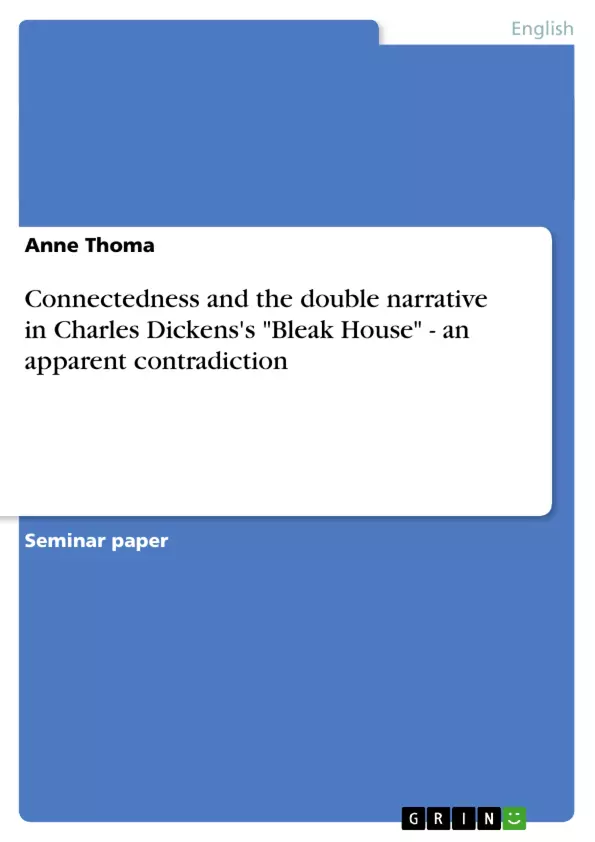[...] The aim of the present paper is to show that the dual narrative does not undercut the idea of connectedness despite its divisive appearance. Some subtasks will pave the way for this conclusion. I will first give some examples of how major elements of the no vel are interlinked. Chancery will prove as the emblem of the corruption that has spread far beyond the doors of the law courts and touches upon all the social classes. Tom-all-Alone’s and the aristocracy, poor and rich, have secrete links, some created vo luntarily, some created less voluntarily. Second, I will characterise the two narrators separately, with Esther being analysed both in her narrating function and in her role as a character of Bleak House. The analysis of the effect of combining the two tellers will lead to a result different from that of a mere glance at the of surface of the structure. I will show how the narrators’ accounts are juxtaposed and thereby reinforce each other, and how their unification yields what Graham Storey calls a “third dimension”, an overlapping of two different view points causing a deeper perception of the Bleak House world (20). However, I will also show a negative interpretation of the relationship between the two narrators by following Patricia Ingham’s essay on deixis in Bleak House. Finally, all the relationships will hint at a system within which the holders of the ties are kept: “Dickens wanted […] the reader to perceive the world of Bleak House in terms of surface disconnection and isolation, and underlying unity […] Bleak House stands or falls as a portrayal as a system” (Hawthorn 63). My thesis is that Bleak House teaches the reader how to combine apparently loose and disconnected elements and look at them as a system. This task posed and carried out by the plot of the novel is simultaneously mirrored in its form. The double narration sends the reader on a quest to find Esther and the 3rd person narrator as two sides of one coin, independent in terms of their nature, but relating to a common situation.
Inhaltsverzeichnis (Table of Contents)
- 1 Introduction
- 2 Connectedness and the double narrative in Charles Dickens's Bleak House - An apparent contradiction
- 2.1 Connectedness: Links between Chancery, the upper, middle and working classes and Tom-all-Alone's
- 2.1.1 An account of the historical context: Dickens and the Victorian grievances
- 2.1.2 Local connectedness
- 2.1.3 Physical and lingual connectedness
- 2.1.4 Family ties and thematic connectedness
- 2.2 Apparent discontinuity: the double narrative
- 2.2.1 The third person narrator
- 2.2.2 Esther as a character and as a narrator
- 2.2.3 The superimposition of the two narratives
- 2.1 Connectedness: Links between Chancery, the upper, middle and working classes and Tom-all-Alone's
- 3 Conclusion
Zielsetzung und Themenschwerpunkte (Objectives and Key Themes)
This essay explores the concept of connectedness in Charles Dickens's Bleak House, specifically focusing on the apparent contradiction between the interconnectedness of its characters and settings and the fragmented, dual narrative structure. The paper aims to demonstrate that the dual narrative does not undermine the idea of interconnectedness, but rather reinforces it through a deeper understanding of the novel's world.
- The interconnectedness of various elements in Bleak House, including Chancery, the upper, middle, and working classes, and the slum of Tom-all-Alone's.
- The role of Chancery as an emblem of corruption that extends beyond the legal system and affects all social classes.
- The analysis of the dual narrative structure, exploring the roles of both the third-person narrator and Esther as a character and narrator.
- The impact of the juxtaposed narratives on the reader's perception of Bleak House, creating a "third dimension" and a deeper understanding of the interconnectedness within the novel's world.
- The significance of the dual narrative as a tool for highlighting the underlying system of relationships that governs the novel's characters and events.
Zusammenfassung der Kapitel (Chapter Summaries)
The essay begins by introducing the central theme of connectedness in Bleak House, highlighting the seemingly contradictory nature of its dual narrative structure. It establishes that the novel presents a world of fragmented relationships and isolated individuals while simultaneously demonstrating their interconnectedness through various elements, such as family ties, social hierarchies, and shared experiences.
The essay then dives into the concept of connectedness, providing examples of how major elements of the novel are interlinked. It explores the role of Chancery as a symbol of corruption that permeates all social classes, highlighting its impact on the lives of individuals like Miss Flite, Gridley, and Richard. The essay further analyzes the connections between Tom-all-Alone's, the Dedlocks' mansion, John Jarndyce's Bleak House, and the brick-makers' hovel, demonstrating their interconnectedness through various social and physical relationships.
Next, the essay examines the dual narrative structure, analyzing the roles of the third-person narrator and Esther. It explores their distinct perspectives, highlighting how their combined narrative creates a deeper understanding of the novel's world. The essay also examines the juxtaposition of their accounts, showcasing how they complement and reinforce each other, ultimately contributing to a richer interpretation of the novel's themes.
Schlüsselwörter (Keywords)
The main keywords and focus topics of the essay are: Bleak House, Charles Dickens, connectedness, dual narrative, Chancery, social class, corruption, Tom-all-Alone's, third-person narrator, Esther Summerson, narrative perspective, interconnectedness, system, Victorian grievances, social issues, and literary analysis.
- Citation du texte
- Anne Thoma (Auteur), 2004, Connectedness and the double narrative in Charles Dickens's "Bleak House" - an apparent contradiction, Munich, GRIN Verlag, https://www.grin.com/document/22008



